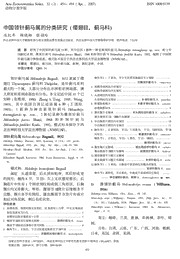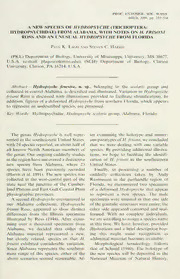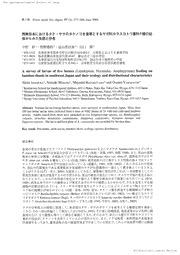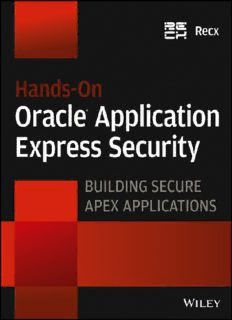
Hands-On Oracle Application Express Security: Building Secure Apex Applications PDF
Preview Hands-On Oracle Application Express Security: Building Secure Apex Applications
CONTENTS Introduction Chapter 1: Access Control The Problem The Solution Authentication Authorization Summary Chapter 2: Cross-Site Scripting The Problem The Solution Examples Understanding Context Reports Direct Output Summary Chapter 3: SQL Injection The Problem The Solution Examples Dynamic SQL – Execute Immediate Dynamic SQL – Cursors Dynamic SQL – APEX API Function Returning SQL Query Substitution Variables Summary Chapter 4: Item Protection The Problem The Solution Validations Value Protected Page Access Protection Session State Protection Examples Summary Appendix A: Using Apexsec to Locate Security Risks Appendix B: Updating Item Protection Appendix C: Untrusted Data Processing INTRODUCTION AT RECX we’ve been involved in the world of IT Security for more than a decade. We were involved in some of the first penetration tests performed in the UK, where large organizations and government departments allowed ethical hackers into their networks to determine the risk they faced from what are now known as cyber attacks. As web applications rose in popularity around the turn of the century, we worked to develop tools and tactics to assist in attacking sites for customers. As more content was placed within web-based systems, this area of research grew almost in tandem with the number of real-world attacks that were happening against Internet-facing websites. In recent years, we became exposed to Oracle Application Express (APEX) and realized that there was no single resource for developers on securing their APEX applications. We were able to break into APEX applications in a myriad of ways after learning about the unique structure of the APEX environment. But we had to learn from scratch why the security flaws existed and how to explain to developers the steps required to resolve the risks. We’ve collated this experience and advice into this book to help any APEX developer create secure APEX applications. Oracle APEX use is booming, and we’re seeing more Oracle customers choosing APEX for presentation of their business data from the database. Some customers have hundreds of APEX applications, ranging in complexity from simple data presentation and reporting through to complex business process management and geospatial analysis. Many have serious security requirements and need to ensure that their data is protected both from unknown parties operating on their networks, and also their “trusted” users acting with malicious intent. APEX is a great tool for rapidly getting raw data out of the database and into a familiar browser environment for users. Whereas there is a gain in terms of functionality in this Rapid Application Development (RAD) model, what we often see is a detrimental effect on security. That’s where Recx comes in — we hope this book is useful for all levels of APEX developers to understand the common risks faced by web applications, how they occur within APEX, and the simple steps required to ensure applications are robust against attack. STRUCTURE The book is structured into four main sections: Access Control: Protecting resources within applications with appropriate security controls prevents unauthorized disclosure of data. Cross-Site Scripting: These attacks are common in all web applications and allow people attacking your site to act on behalf of other users by injecting into your content. SQL Injection: A common attack vector that is widely used to compromise sites by extracting sensitive data. Item Protection: This useful security feature of APEX is often misunderstood, but when used correctly it adds a strong layer of protection to the application. We believe in the learn-by-example approach to teaching security, and have structured this book so you can follow the discussions in a practical manner by creating pages within an APEX application that have specific security flaws. We demonstrate how attackers exploit the vulnerabilities so you are familiar with the mechanisms used against systems. By showing how to fix the issues, we can demonstrate they are no longer exploitable, and hopefully help clarify the real root cause of the problem and the simplicity of protecting against the threats. If you prefer, you can read this book without actually trying the examples, and use them as illustrations of the threats against APEX applications. All of the examples in this book are actually from real-world customer applications, sanitized and simplified to communicate the core issue in an understandable form. Some will look so simple that they may appear to have been specifically manufactured — trust us, they existed in some form within real applications, and are less obviously vulnerable when embedded within a hundred-page, highly complex APEX application! The examples, when followed, result in a world’s-most-vulnerable APEX application that you can keep in your tool bag and use to experiment on with the real issues you face in your own code. The complete example application is also provided for download for you to directly import into your test environment and start hacking. SOME BASICS This book takes a hands-on approach, demonstrating security risks to APEX applications by building vulnerable pages, exploiting them, and then changing things so they are secure. As such, to get the most out of this book you should be familiar with building APEX applications; pretty much any APEX developer should be able to follow the examples. Two other areas are worth getting up to speed with: the APEX URL format and the JavaScript console. APEX URL Format The URLs within APEX applications have a unique structure, and differ from normal web applications: http://apex.oracle.com/pls/apex/f?p=12556:1:6900596019210::::: Most direct requests go via the f procedure with a single parameter, p. This parameter is a colon-separated list that breaks down as follows: Application ID Page ID Session ID A request string The debug flag (YES or NO) A list of pages for which the cache will be cleared A comma-separated list of item names A comma-separated list of item values The printer-friendly output flag (YES or blank) When using (and attacking) APEX applications, the main parts that we get involved with are the list of item names and values. Most web application technologies pass parameters on the URL in the following form: http://www.recx.co.uk/test.php?name=recx&show=all You see two parameters here, name and show. The equivalent within APEX would be http://apex.oracle.com/pls/apex/f? p=12556:1:6900596019210::::P1_NAME,P1_SHOW:recx,all Usually, parameters can be URL-encoded to allow any character to be contained in a value (for example, name=recx%26friends would embed an ampersand). This works in APEX with two exceptions: the comma, and the colon characters can’t be encoded in a value. To set an item value so that it contains a comma, surround the list of item values with backslash characters: http://apex.oracle.com/pls/apex/f? p=12556:1:6900596019210::::P1_NAME,P1_SHOW:\recx,and,friends\,all This sets the P1_NAME value to recx,and,friends. When attacking APEX applications, this is useful because commas can arise in some exploits, such as SQL Injection and Cross-Site Scripting. The colon character can also be passed in an item value, but not via the f procedure. To set an item value to contain a colon, you have to call wwv_flow.show directly: http://apex.oracle.com/pls/apex/wwv_flow.show? p_flow_id=12556&p_flow_step_id=99&p_instance=8422060846284&p_arg_name=P99_TEXT1&p_arg_value=recx:security The p_flow_id is the application ID, the p_flow_step_id parameter is the page ID, and p_instance represents the session. You can then pass p_arg_name and p_arg_value pairs to specify item name/values, using standard URL encoding to set any character. This is unsupported, and the wwv_flow package and show procedure may at some point change, so APEX applications shouldn’t make use of this feature for normal operations. But, if attacking an APEX application, you can use this to get a colon into a value and into your exploit string. JavaScript Console All major browsers now have a very handy JavaScript console. In this book we use Chrome, but Firefox and Internet Explorer have the same feature and the same JavaScript commands will work. As security researchers investigating an APEX application’s exploitability, we use the JavaScript console for a number of tasks: Making Ajax calls, to invoke processes or set item values. Modifying components on a page; for example, to make hidden fields into text fields so they can be easily modified. Testing and debugging Cross-Site Scripting vulnerabilities. To make an Ajax call, you use the htmldb_Get function within the JavaScript console: var ajax = new htmldb_Get(null, $x('pFlowId').value, 'APPLICATION_PROCESS=SomeProcess', 1); // Page number ajax.get(); You can use this same code to set an item value, by specifying an empty process name: var ajax = new htmldb_Get(null, $x('pFlowId').value, 'APPLICATION_PROCESS=', 1); // Page number ajax.add('P1_TEXT','data'); ajax.get(); You will see how this particular Ajax call can be very useful mechanism for modifying items that are protected by checksums in Chapter 4, “Item Protection.” To modify a hidden item on a page so it is editable, you can use the following JavaScript, which uses jQuery to duplicate a form element: $('#P1_HIDDEN').detach() .attr('type','text') .insertAfter('#P1_SUBMIT'); A text field, with the same ID, name, and value as the hidden field, is placed after the submit button. The contents can then be changed in the browser and submitted to the APEX application. OTHER RESOURCES This book presents a number of security risks faced by web applications and investigates specifically how these emerge within the APEX environment. From our consulting experience we know these vulnerabilities are common in APEX applications, but they are not unique to the APEX world. Similar issues exist in any web application framework. To further your understanding of generic attacks against web applications, we highly recommend the Web Application Hackers Handbook (Stuttard and Pinto, 2007). It is also worth considering the security applied at the database layer, and we would also point out the Database Hackers Handbook (Litchfield et al., 2005) as an invaluable resource when testing a security your environment. Chapter 1 Access Control One of the most basic forms of protection that any web application must utilize is the enforcement of an authentication and authorization policy. Authentication deals with identifying users to the application; in APEX this is provided by a number of default authentication schemes and can be extended using a custom authentication scheme. Authorization is the process of assessing whether the authenticated user is privileged to access certain data or perform a particular action. The term access control covers both aspects, and access-control vulnerabilities arise when either authentication can be abused to allow access to an application without valid credentials, or when authorization is incorrectly applied, allowing valid users to access parts of the application for which they should not have privileges. One of the great things about APEX is the capability to apply authorization schemes to a wide range of components. At a simple level, pages within an APEX application can be protected by your authorization scheme to prevent access to certain sets of users. The applicability of authorization schemes is a lot more granular: reports, buttons, and processes can all also be protected. Users with different privileges can then only view or access specific components on a page. While APEX provides a great access control model, there are some common mistakes that are made where data and functionality do not get protected as you might expect. This chapter will guide you through the various access control features and show how they can be used securely in your applications. THE PROBLEM When authentication or authorization is not applied correctly, an unauthenticated user with no access to the application may be able to view and interact with the data it is intended to protect. Valid (but malicious) users of the application may also be able to invoke operations that should be restricted to a limited subset of users. In our experience performing security assessments of APEX applications, we can say that although APEX provides fantastic flexibility and granularity with authorization, in many cases such protection is not defined or applied correctly. As an APEX application grows and matures, we often see newer pages and components that do not have the protection they require. In one (extreme!) case, we analyzed an application where the Create Admin User page was not protected, and could be accessed by any authenticated user of the application. THE SOLUTION By ensuring that the authentication scheme used by your APEX application is robust and conforms to best practice, you can be confident that only legitimate users of the application should have access. Of course, other attacks against an APEX application can allow those malicious attackers to get in even when authentication is defined correctly, but these attacks (such as using Cross-Site Scripting to steal a valid user’s credentials, or SQL Injection to access arbitrary data within the database) can be mitigated in other ways and are discussed later in this book. Authorization should be applied to those areas within an application that need to be protected from subsets of valid authenticated users. Only very simple applications are designed with one generic user level; most have at least some notion of “role” with base-level users, and administrative functionality for a specific group of users. We’re not going to cover designing and documenting an application’s access- control model, as this is very dependent on the specific requirements of the application. However, this is a crucial step when developing any system. Such requirements should be captured when the system is planned, and then once implemented, the access-control structure can be compared with the initial intentions. Instead, we present some common access-control mishaps that we’ve observed across a number of APEX applications, and discuss how the simple addition of access-control settings can secure the APEX application.
Description:The list of books you might like

A Thousand Boy Kisses

Atomic Habits James Clear

The 48 Laws of Power

The Mountain Is You
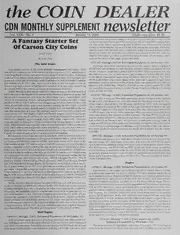
The Coin Dealer Newsletter Monthly Supplement Newsletter: 2006
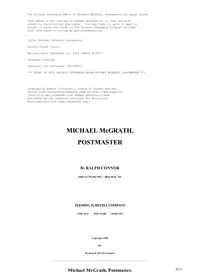
Michael McGrath Postmaster by Ralph Connor

14 занимательных эссе о языке Haskell и функциональном программировании
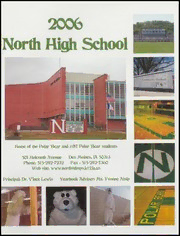
Polar Bear: 2006

Glossary
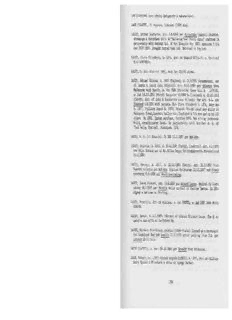
C. Augusta, labourer (1889 Alm).

Ojo por ojo

The House of the Secret by Claude Farrre
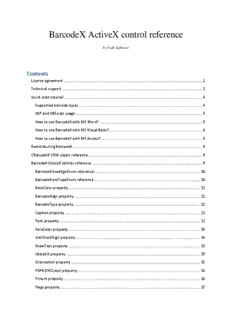
BarcodeX ActiveX control reference
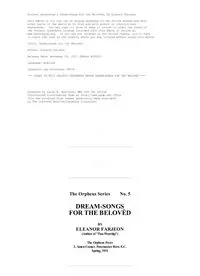
DreamSongs for the Belovd by Eleanor Farjeon
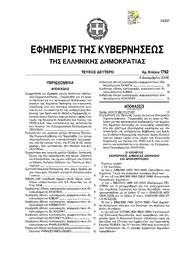
Greek Government Gazette: Part 2, 2006 no. 1792
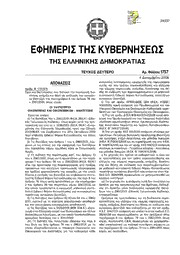
Greek Government Gazette: Part 2, 2006 no. 1757
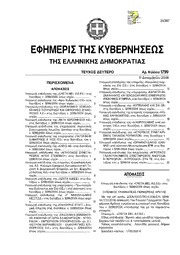
Greek Government Gazette: Part 2, 2006 no. 1799
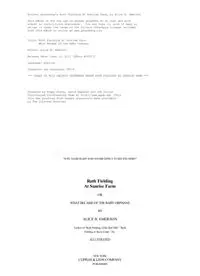
Ruth Fielding at Sunrise Farm

op1278241-1001

Calendar of Bristol Apprentice Book, 1532-1565

